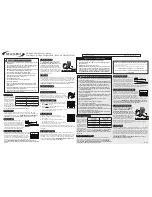
9 – English
OPERATION
WARNING:
The nailer will not function properly if the selector
is not securely seated in either position ( ) or
(
). Always assure the selector is seated properly
to avoid an unexpected fastener discharge and
possible serious personal injury.
Reconnect the tool to the air supply.
Grip the tool firmly to maintain control. Position the nose
of the tool onto the work surface.
Push the tool against the work surface to depress the
workpiece contact.
Squeeze the trigger to drive a fastener.
Allow the tool to recoil away from the work surface as the
fastener is driven.
Always remove your finger from the trigger when the
desired number of staples has been driven.
CONTACT ACTUATION MODE
Contact actuation allows very fast repetitive fastener
placement.
Disconnect the tool from the air supply.
Depress the actuation mode selector.
Rotate the selector to Position (
).
Release the actuation mode selector.
NOTE:
The actuation mode selector is spring loaded and
held in position by locking tab to prevent movement during
operation.
Reconnect the tool to the air supply.
Grip the tool firmly to maintain control.
Squeeze and hold the trigger. Push the tool against the
work surface to depress the workpiece contact and drive
a fastener.
Allow the tool to recoil away from the work surface as the
fastener is driven.
Always remove your finger from the trigger when the
desired number of staples has been driven.
NOTE:
In Contact Actuation Mode, the tool may also be
operated by depressing the workpiece contact against the
surface and squeezing the trigger.
WARNING:
During normal use the tool will recoil immediately
after driving a fastener. This is a normal function
of the tool.
Do not attempt to prevent the recoil by
holding the tool against the work. Restriction to the
recoil can result in a second fastener being driven
from the tool. Grip the handle firmly, let the tool do
the work, and do not place second hand on top of
tool or near exhaust at any time. Failure to heed
this warning can result in serious personal injury.
SETTING THE AIR PRESSURE
The amount of air pressure required will depend on the size
of the fastener and the workpiece material.
Begin testing the depth of drive by driving a test fastener into
the same type of workpiece material used for the actual job.
Drive a test fastener with the air pressure set at 90-95 psi.
Raise or lower the air pressure to find the lowest setting that
will perform the job with consistent results.
It may be possible to achieve the desired depth with air
pressure adjustments alone. If finer adjustments are needed,
use the depth of drive adjustment on the tool.
DEPTH-OF-DRIVE ADJUSTMENT
See Figure 7, page 15.
The driving depth of the staple may be adjusted. It is advis-
able to test the depth on a scrap workpiece to determine
the required depth for the application.
To determine depth-of-drive, first adjust the air pressure and
drive a test staple. To achieve the desired depth, use the
depth-of-drive adjustment on the tool.
Disconnect the tool from the air supply.
Turn the depth selector left or right to change the driving
depth.
Reconnect the tool to the air supply.
Drive a test staple after each adjustment until the desired
depth is set.
WARNING:
Disconnect the tool from the air supply before
removing staples or clearing a jammed fastener.
Failure to do so could result in serious personal
injury.
REMOVING STAPLES FROM THE TOOL
See Figure 8, page 15.
Disconnect the tool from the air supply.
WARNING:
Disconnect the tool from the air supply before
removing staples. Failure to do so could result in
serious personal injury.
While holding the tool upside down, depress the latch
located at the rear of the magazine and slide the magazine
open.
Rotate the tool to the normal operating position, allowing
the staple strip to drop out of the magazine.










































